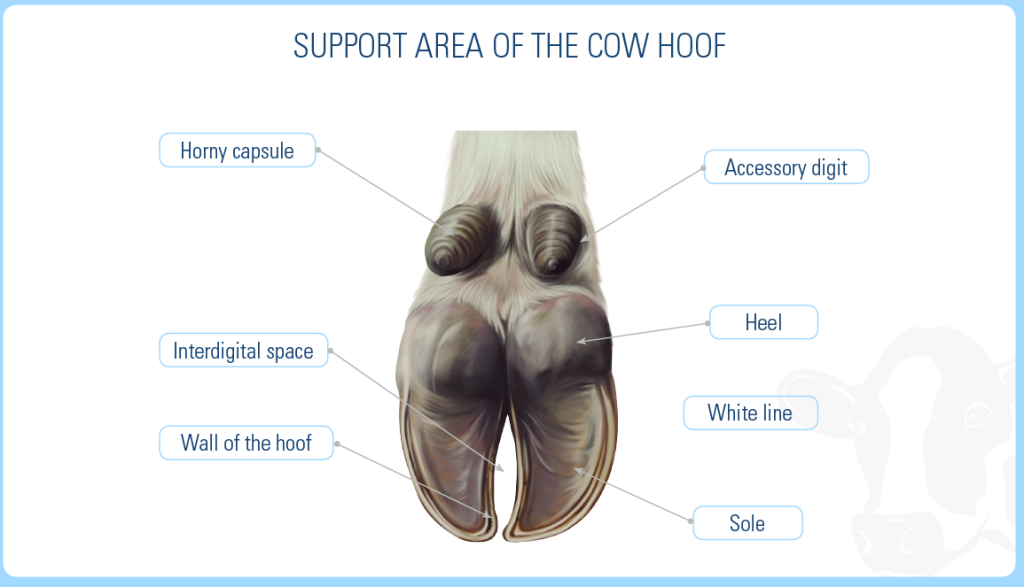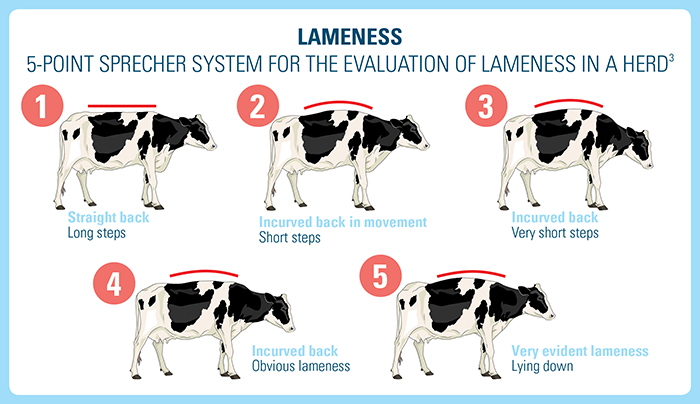

Lameness
After mastitis, lameness is the most economically important disease of dairy cattle. It has a negative impact on reproductive performance and constitutes an increased risk for early culling. Lameness has also a negative effect on animal behavior and welfare.
Causes of lameness are classified as either infectious or non-infectious.
Infectious
They are caused by microorganisms, such as bacteria or viruses, and are characterized by a sudden onset, bringing acute pain. Most are treatable with some management interventions such as maintaining a drier environment, adopting a rigorous footbathing schedule and avoiding contact of hooves with manure.
- Digital dermatitis
- Interdigital dermatitis
Non-Infectious
They can be due to housing conditions, improper nutrition such as hypovitaminosis, or as a consequence of other metabolic diseases, such as ketosis or hypoglycemia. Also, certain environmental factors and the genetic heritability can play an important role in developing lameness.
- Sole ulcers
- White line disease
- Interdigital Phlegmona
- Laminitis
- Breeding
- Nutrition
- Housing design
- Flooring surface
- Farm tracks/raceways
- Herd management
- Stockmanship
- Concurrent disease
- Genetics

The mean prevalence of lameness has been estimated at 20.6% in dairy herds1.
Direct costs associated with lameness in dairy cattle include:
- Reduced milk production
- Veterinary and producer labor and cost
Indirect costs include:
- Reduced fertility
- Increased risk of secondary diseases
- Increased risk of culling: At least 10% of cows in a herd are culled for reasons related to lameness.
- Loss of body condition: Lame cows are less aggressive in their struggle for feed.
Lameness affects fertility1:
- Indirectly, because of its negative impact on energy balance and thus, body condition.
- Directly, by altering behavior:
- Shorter time of standing and walking, more time lying down
- Less time at the feedbunk; lower dry matter intake
- Stress has important negative effects on ovarian function.
Consequences on fertility:
- Shorter estrus and reduced expression of sexual behavior
- Lower average conception rate and pregnancy rate
- Higher rates of services per conception
- Longer interval from calving to conception
- Higher incidence of cystic ovaries
Around 80% of cases of lameness are due to hoof problems, and the remainder to leg damage. Foot lameness is seen most commonly in the hind feet, particularly in the outer claws.
A good history, observation of stance and stride, and physical examination are critical to the diagnosis of lameness in cattle.
Lameness diagnosis consists of localizing the lameness to a specific limb or structure and determining the cause.
If no obvious defects are initially observed, it may be useful to tap on the bottom of the hoof with a hammer and observing a pain response to localize the lameness. Hoof testers, such as those utilized for horses, can also be used. They apply pressure to a localized part of the hoof when squeezed.
Lame Cows Show Changes in2:
- Gait patterns: Lame cows walk slower and have longer stride durations.
- Posture movement patterns: Lame cows have a more pronounced arched-back posture, both while standing and walking.
- Weight distribution patterns: Lame cows tend to shift their body weight onto non-affected limbs to reduce pain
- Behavior: Lame cows spend longer lying times, longer periods of standing in alleys and decreased feeding behavior.
Scoring cattle for lameness based on changes in locomotion or behavior is essential for farmers to find and treat their lame animals.

Once a cause of lameness is identified, treatment options can be considered4. For example, topical sprays are very useful to treat digital and interdigital dermatitis, whereas treatment with injectable antibiotics has been successful with or without topical treatment of the wound in the case of interdigital phlegmona.
A lameness control program should consist of:
- Record and diagnose all clinical cases.
- Routine functional hoof trimming, once or twice a year to improve comfort and performance at drying off.
- Foot bathing: to improve foot hygiene is a major factor for reducing the lameness due to foul-in-the-foot, interdigital growths and digital dermatitis in cows with benefits to claw and horn quality and heel horn health.
- Proper nutrition management: most lameness problems occur within the first 100 days postpartum. Successful feeding programs improve feed intake, minimize rumen acidosis and maximize energy intake during early lactation.
- Housing and environment: dairy cattle confined to concrete floors may have more feet and leg problems. Waiting areas and walking lanes should be kept free of manure as much as possible and good stall ventilation will keep them dry. Properly designed freestalls will encourage cows to lay down can diminish claw problems. Furthermore, rubber mats placed in feedlines and traffic lanes may be beneficial.
- Management on farm: all people involved in the movements of cows must be patient and not force them to move quickly.
- Olechnowicz, Jan & Jaśkowski, J.M.. (2011). Relation between clinical lameness and reproductive performance in dairy cows. Medycyna Wet. 67 (1):5-9.
- Van Nuffel A, Zwertvaegher I, Pluym L. Lameness Detection in Dairy Cows: Part 1. How to Distinguish between Non-Lame and Lame Cows Based on Differences in Locomotion or Behavior. Animals (Basel). 2015;5(3):838-60.
- Sprecher DJ, Hostetler DE, Kaneene JB. 1997. A lameness scoring system that uses posture and gait to predict dairy cattle reproductive performance. Theriogenology 15;47(6):1179-87
- Stokka G, Smith JF, Dunham JR, Van Anne T. K-State Research & Extension. Lameness in dairy cattle. https://articles.extension.org/pages/10855/lameness-in-dairy-cattle

